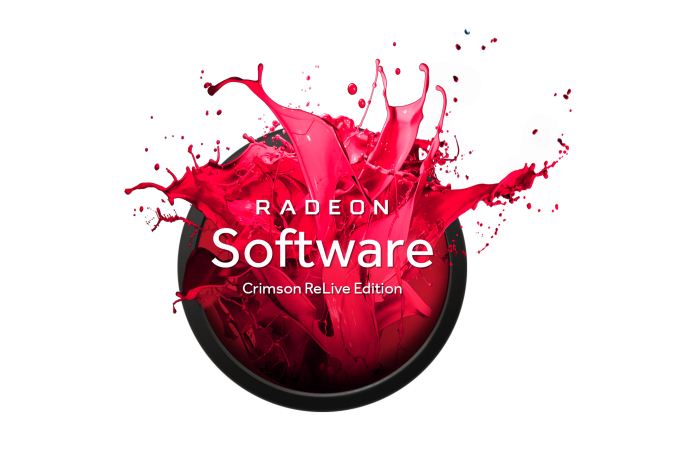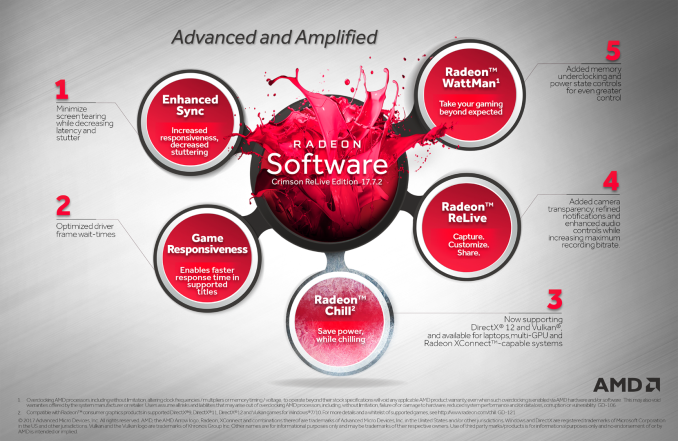AMD Releases Radeon Software Crimson ReLive Edition 17.7.2: ReLive Edition Refined for Gamers and Developers
by Nate Oh on July 26, 2017 5:00 PM EST
It’s been roughly 7 months since AMD released the Crimson ReLive Edition update for Radeon Software, the latest entry in their annual cadence for major driver revisions and feature additions. Today’s launch sees AMD/RTG bring the sequentially and demurely named “Radeon Software Crimson ReLive Edition 17.7.2,” but for all intents and purposes 17.7.2 serves as a major feature revamp to the original Crimson ReLive Edition, as well as refinement of Radeon ReLive and Radeon Chill. In addition to performance optimizations and feature changes, 17.7.2 also introduces AMD’s new Enhanced Sync (comparable to NVIDIA’s Fast Sync and Adaptive V-Sync) and Radeon GPU Profiler, a low-level GCN hardware tracing developer tool.
Taking a step back, 17.7.2 adds to the regular pace of AMD’s graphics overhauls in recent years: Catalyst Omega (12/2014), Radeon Software Crimson Edition (11/2015), and Radeon Software Crimson ReLive Edition (12/2016). While not a wholly new Radeon Software edition, 17.7.2 does show a commitment to improving graphics software features outside of those yearly ‘all-in-one wonder drivers,’ building on AMD’s ongoing efforts to improve user experience. On that topic, AMD today is also launching the Radeon Software Vanguard Beta Tester program.
Overview of Radeon Software 17.7.2: What’s in the Driver?
Similar to the original Crimson ReLive Edition, AMD has broadly outlined 17.7.2 into two areas: gamers and game developers. Many of the changes and improvements revolve around previously introduced software features; for readers unfamiliar with the mentioned features, more detailed looks can be found in Ryan and Daniel’s Crimson Edition launch piece, as well as Ian’s Crimson ReLive Edition launch piece.
For gamers, 17.7.2 includes quality-of-life changes for Radeon Software, fulfilling the top two most-voted feature requests: folding in Radeon Additional Settings into Radeon Settings, and bringing back advanced video feature options with new per-display color controls. AMD has also brought some quality-of-life and recording improvements to Radeon ReLive, as well as broader support for Radeon Chill in terms of more games/APIs and more GPU configurations (including Radeon XConnect). In the same vein, WattMan has been updated with memory underclocking and “per power state” control, while FRTC has been updated with DX12 and mGPU support. Rounding out these feature enhancements is Radeon Software support for AMD’s new Enhanced Sync, a V-Sync replacement that can mitigate latency and stuttering. Lastly, 17.7.2 brings general driver optimizations, as well as driver frame wait-time and shader caching improvements.
Moving on, the developer oriented changes fall under the GPUOpen umbrella. First off is an update to Open Capture and Analytics Tool (OCAT) – AMD's open source successor to FRAPS – which was introduced in Crimson ReLive. AMD stated that this is largely a stability update, particularly targeting certain misbehaving games, and additionally brings Windows 10 Creators Update support.
The second is a new tool for DX12 and Vulkan applications: Radeon GPU Profiler (RGP). Already in the hands of select developers and partners, RGP takes advantage of GCN hardware thread tracing to allow low-level event tracking and visualization of graphics workloads. In essence, RGP opens up GCN GPUs to developers in a way that compares to console development. RGP works hand-in-hand with another new developer feature, the Radeon Developer Driver (RDD), which allows creation of trace files and access to internal driver settings. As a unified consumer and developer driver, RDD enables RGP to “just work.”
Concluding the new developer features is the AMD LiquidVR 360 SDK. This enables end-to-end GPU-accelerated HEVC 4K x 4K VR video playback, as well as 6-channel spatial audio in the form of Immersive Ambisonic Audio.













30 Comments
View All Comments
Ascaris - Saturday, July 29, 2017 - link
You might be surprised. There are a bunch of us who are moving to 8.1 in order to avoid 10. On some of the sites I frequent, Windows 8.1 is probably about as popular as 7. Once people realize that you can de-stupidize 8.1 and have something that can ward off 10 for more than half a decade, it begins to look pretty good.It took something as bad as 10 to make 8 look like a reasonable product. I avoided 8 like the plague when it came out; I only migrated from XP to 7 well after 8.x had already become the new "Vista." But after a year of Windows 10, I looked back at 8.1 and wondered why I'd hated it so; it seemed so benign compared to 10. Yes, it needed a lot of help to get the UI into shape, but I realized that I used those very same tools on 7, so what difference would it really make if I did that on 8 also?
I'm very demanding when it comes to what I will tolerate in a UI, and I'm very much a traditionalist, and I use 8.1 on both my main PCs. Windows 10, on the other hand, I would not even consider at this point. The main issues are in the first couple paragraphs here, but even if those were fixed, Windows 10 still would not be good enough because of its UI. Fix all of that and make it so I never need to see any UWP, ever, and then maybe I will reconsider, but not until then. When 8.1 runs out of security support, either 10 will have evolved into something I will use, or I will make the jump completely to Linux. I'm already halfway there; I dual boot 8.1 and Linux Mint 18.2 now.
Hurr Durr - Saturday, July 29, 2017 - link
>muh loonix I`ll move to loonix I pinky swearYeah, right. Loonix UX attempts by professional neckbeard autismos alone make any Windows look like something from the much better future timeline, and then there is loonix software written and maintained by 13-year olds.
Ascaris - Saturday, July 29, 2017 - link
Your username is undoubtedly the most intelligent comment you've ever made.gr33nbits - Sunday, July 30, 2017 - link
Windows 10 is the best SO so far made by MS and why Linux? When you can have all in one like Windows 10 you prefer a dual boot with Windows 8.1 and Linux, makes no sense.Cryio - Tuesday, August 22, 2017 - link
I'm not using W8.1. I'm just surprised there isn't any official support.Gigaplex - Wednesday, July 26, 2017 - link
"For gamers, 17.7.2 includes quality-of-life changes for Radeon Software, fulfilling the top two most-voted feature requests: folding in Radeon Additional Settings into Radeon Settings, and bringing back advanced video feature options with new per-display color controls"I've only skimmed through this article, but this is promising. With the Relive branding, I lost the ability to configure things like pixel format (RGB vs YUV) and HDMI overscan. Both of which default to wrong values for my HDMI LCD monitor.
lowlymarine - Wednesday, July 26, 2017 - link
Pixel format is definitely back for me in this new driver, though I never lost HDMI overscan controls in the first place so I'm not sure what to say there.Gigaplex - Thursday, July 27, 2017 - link
Maybe I just couldn't find the HDMI overscan setting in the new layout? *shrug*nathanddrews - Thursday, July 27, 2017 - link
I haven't updated to this version yet, but HDMI overscan settings were buried within "additional settings" in the first iterations of ReLive and would still pop up in the old CCC window.The last ReLive driver I tried had the overscan setting in the new format, but you could only change the overscan if you disabled Virtual Super Resolution. Seems like a stupid tradeoff.
Gigaplex - Friday, July 28, 2017 - link
Nothing happens when I click "additional settings", that would explain why I couldn't find the buried HDMI settings. I also don't have the old CCC window, it was purged when I updated to ReLive.